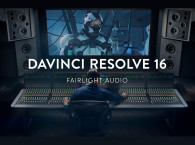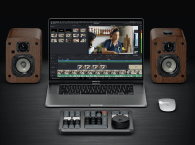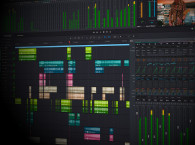
Blackmagic Design continues to expand the possibilities for users of the popular DaVinci Resolve software, which offers complete integrated tools for all editing and post-production needs, with simultaneous support for macOS, Windows and Linux. DaVinci Resolve 16.2 has major new updates for editing in the Fairlight audio timeline when using simply a mouse and keyboard. This is because the new edit selection mode unlocks functionality previously only available via the audio editor on the full Fairlight console, so editing is much faster than before. In addition, the edit selection mode makes adding fades, cuts and even moving clips only a mouse click away, new scalable waveforms let users zoom in without changing the volume, and bouncing now allows rendering a clip with custom sound effects directly from the Fairlight timeline.
Adding multiple clips is easier as they can now be added vertically to the timeline, not just horizontally, making it easier to add multiple tracks of audio at once. Multichannel tracks can now be converted into linked groups directly in the timeline so users no longer have to change clips manually and reimport. There's added support for frame boundary editing which improves file export compatibility for film and broadcast deliveries. Frame boundary editing now adds precision so users can easily trim to frame boundaries without having to zoom all the way in the timeline. Modifier keys are now supported so clips can be duplicated directly in the timeline using the keyboard and mouse. Users can also copy clips across multiple timelines with ease.
DaVinci Resolve 16.2 also includes support for the Blackmagic Fairlight Sound Library with new support for metadata based searches, so users don’t need to know the filename to find a sound effect. Search results also display both the filename and description so finding the perfect sound effect is faster and easier than before. Finding audio effects is also faster with automatic sorting that will separate them first by category, and then by native or third party plugins. Effects can also be marked as a favorite so they move to the top of the list, making navigation easier than ever.
MPEG-H 3D immersive audio bussing and monitoring workflows are now supported. Additionally, improved pan and balance behavior includes the ability to constrain panning. This new release also includes improvements in AAF import and export, with things like AAF files that contain multichannels being recognized as linked groups automatically. For traditional Fairlight users, this new update also makes major improvements in importing old legacy Fairlight projects.

The extensive Fairlight audio editing also has index improvements. The edit index is now available in the Fairlight page and works as it does in the other pages, displaying a list of all media used, simply click on a clip to navigate directly to its location in the timeline. The track index now supports drag selections for mute, solo, record enable and lock as well as visibility controls so customers can quickly swipe through a stack of tracks without having to click on each one individually. Audio tracks can also be rearranged by click and dragging a single track or a group of tracks in the track index.
This new software also improves audio mixing. A new EQ curve preset for clip EQ in the inspector allows removal of troublesome frequencies. New FairlightFX filters include a new meter plug-in that adds a floating meter for any track or bus to keep an eye on levels even if the monitoring panel or mixer are closed. There’s also a new LFE filter designed to smoothly roll off the higher frequencies when mixing low frequency effects in surround.
Working with immersive sound workflows using the Fairlight audio editor has been updated and now includes dedicated controls for panning up and down. Additionally, clip EQ can now be altered in the inspector on the editor panel. Copy and paste functions have been updated and now all attributes are copied, including EQ, automation and clip gain. Audio engineers can set up their preferred workflow including creating and applying their own presets for clip EQ. Plugin parameters can also be customized or added so users have fast access to their preferred toolset.
Clip levels can now be changed relatively, this allows users to adjust the overall gain while respecting existing adjustments. Clip levels can also be reset to unity, easily removing any level adjustments that may have previously been made. Fades can also be deleted directly from the Fairlight Editor, making it faster to do than before. Sound engineers can also now save their preferred track view so they get the view they want without having to create it each time. More functions previously only available via the keyboard are now accessible using the panel, including layered editing. This also means that automation curves can also now be selected via the keyboard or audio panel.

Continuing on with the extensive improvements to the Fairlight audio, there has also been major updates to the audio editor transport control. Track navigation is now improved and even works when nothing is selected. Users can navigate directly to the timecode entry window above the timeline from the audio editor panel, and there is added support for high frame rate timecodes. Timecode entry now supports values relative to the current CTI location, so the playhead can move along the timeline relative to the position rather than a set timecode.
This update also improves editing in DaVinci Resolve. Loading and switching timelines on the edit page is now faster with improved performance when working with a large number of audio tracks. Compound clips can now be made from in and out points so editors can be more selective with what media they want directly in the edit page. There is also support for previewing timeline audio when performing live overwrites of video only edits. Now when trimming, the duration will reflect the clip duration as customers actively trim so customers can set a specific clip length. Support for a change transition duration dialog.
The media pool now includes metadata support for audio files with up to 24 embedded channels. Users can also duplicate clips and timelines into the same bin using copy and paste commands. Smart filters now let users sort media based on metadata fields, including keywords and people tag so users can find the clips they need faster.
"We are excited about this update as it has more new features for audio post production," says Grant Petty, Blackmagic Design CEO. "These new features allow complex audio post production work in the Fairlight page using a simple mouse and keyboard. That allows many more people to add professional audio quality to their work because DaVinci Resolve is a free download. That’s very exciting."
DaVinci Resolve 16.2 is available now for download from the Blackmagic Design web site.
www.blackmagicdesign.com






